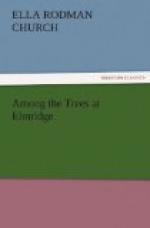[Illustration: LEAF AND FLOWER OF LIME TREE (Tilia).]
“What fun it would be, if we were there, to go and get it!” exclaimed Malcolm. “But don’t bees make honey from the lime trees that grow in this country, too, Miss Harson?”
“Certainly they do; and the beekeepers look anxiously forward to the blossoming of the trees, because they provide such abundant supplies for the busy swarms. The flowers have other uses, too, besides the making of honey: the Swiss are said to obtain a favorite beverage from them, and in the South of France an infusion of the blossoms is taken for colds and hoarseness, and also for fever. ’Active boys climb to the topmost branches and gather the fragrant flowers, which their mothers catch in their aprons for that purpose. An avenue of limes has been ravaged and torn in pieces by the eagerness of the people to gather the blossoms, and they are often made into tea which is a soft sugary beverage in taste a little like licorice.’”
“How queer,” said Clara, “to make tea from flowers!”
“Is it any queerer,” asked her governess, “than to make it from leaves? I should think that the flowers might even be better, and yet I should scarcely like lime-tea that tastes like licorice.”
The children, though, seemed to think that they would like it, and Miss Harson had very little doubt that such would be the case.
“Both the bark and the wood of the lime tree are valuable,” she continued. “The fibres of the bark are strong and firm, and make excellent ropes and cordage. In Sweden and Russia they are made into a kind of matting that is very useful for packing-purposes and in protecting delicate plants from the frost. ’The manufacture of this useful material is carried on in the summer, close by the woods and forests where the lime trees grow in abundance. As soon as the sap begins to ascend freely the bark parts from the wood and can be taken away with ease. Great strips are then peeled off and steeped in water until they separate into layers; the layers are still further divided into smaller strips or ribbons, and are hung up in the shade of the wood, generally on the very tree itself from which they have been taken. After a time they are woven into the matting and sent to market for sale. The Swedish fishermen also manufacture it into a coarse thread for fishing-nets, and from the fibres of the young shoots the Russian peasant makes the strong shoes he wears, using the outer bark for the soles. In Italy the garments of the poorer people are often made of cloth woven from this material.”
“Why, people can fairly live on trees,” said Malcolm. “I didn’t know that they were good for anything but shade—except the trees that have fruit and nuts on ’em.”
“There is a great deal for us all to learn of the works of the Creator,” replied Miss Harson, “and the blessing of trees is not half known. The wood of the lime is said never to be worm-eaten; it is very soft and smooth and of a pale-yellow color. It is used for the famous Tunbridge ware, and is called the carver’s tree, because, as the poet says,




